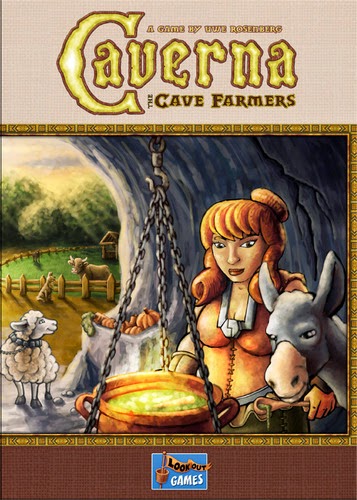Designer Uwe Rosenberg has made many great board games, but among most enthusiasts, the most beloved is his farming game, Agricola. Last year, he decided to serve up a sequel of sorts by releasing Caverna: The Cave Farmers. It's rather hard to get right now for any reasonable price, but my friend somehow managed it, and not long ago I got to try it out.
Caverna transports the farming concept into a new setting. The families the player manages are now living in a cave which they can also mine, and raising animals in pastures just outside their home. The mechanisms are largely the same as Agricola's: each space on the board offers an actions, with new spaces (and new actions) becoming available each round. Some spaces accumulate resources with each round in which they're not taken. Caverna also ropes in a concept or two from Rosenberg's expansions for Agricola, the most notable being the idea of having to "clear land" outside before being able to use it for planting or keeping animals.
So what's new? First, there's the idea of "expeditions." Each member of the family is equipped with a weapon worth some number of strength. When a family is assigned to an expedition, the strength of his weapon determines the effectiveness of that action -- the player can select one or more rewards (depending on the space), and how deeply he can plumb the table of results depends on the strength of the weapon. Expeditions are a great "wild" action to take, letting you mix and match rewards that might normally take you multiple other actions to acquire. So increasing the power of your weapons is key. But an interesting wrinkle is that when assigning workers, you must assign the ones wielding your lowest valued weapons first. In short, your whole family must be kept strong and upgraded if maximizing expeditions is key to your strategy.
The other big wrinkle -- and this is huge -- is in the improvements you can build. In Agricola, these are represented in a large deck of cards. There are hundreds of options, and each player is dealt only a few in any given game. It makes for a tremendous variety, but it can also make for imbalance as not all the options are created equal (or fairly balanced, frankly).
Caverna puts the upgrades on tiles that must be built as rooms in your home, and the entire array of tiles is presented on a board for all players to choose from. No longer can one player simply luck out into an upgrade that other players didn't get; everyone has equal access to every possibility. This does wonders for both fairness in the game and the sense of competition with other players (which already felt pretty high in Agricola). However, it also makes the game even more daunting. Even though there are far fewer tiles here than there were cards in the Agricola deck, there are dozens of options to choose from. Keeping tabs on them all is going to take a Herculean effort, and I fear a new player would simply be lost entirely.
Caverna is probably a better balanced game overall than its predecessor Agricola. But there simply doesn't seem to me to be any way a new player will easily pick up Caverna without first knowing Agricola. Or if he could, it would surely be the most daunting game he'd ever played. I myself certainly would want many more plays of Caverna before I made any solid judgments about it, but for now I'd provisionally grade it an A-. I predict a spirited debate among the German board game fans about which game is better, it or Agricola.

No comments:
Post a Comment